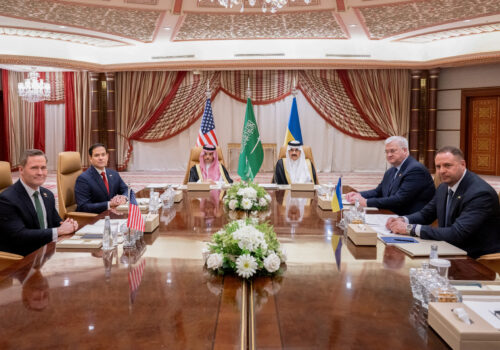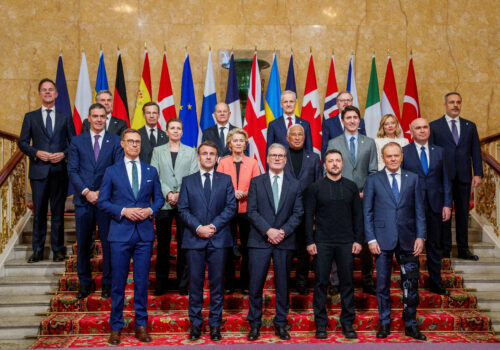Police arrested dozens of Jewish Voice for Peace agitators after they stormed Trump Tower in New York to demand the release of Mahmoud Khalil, the pro-Hamas Columbia University activist in ICE custody.
“We want justice. You say how, free Mahmoud Khalil now,” the JVP activists chanted. “We will not comply, Mahmoud, we are on your side.”
As Jews, we are taking over the Trump Tower to register our mass refusal. We will not stand by as this fascist regime attempts to criminalize Palestinians and all those calling for an end to the Israeli government’s US-funded genocide of the Palestinian people. And we will never… pic.twitter.com/t2Ql8qRBgw
— Jewish Voice for Peace (@jvplive) March 13, 2025
They also held banners proclaiming, “Fight Nazis, Not Students,” “You Can’t Deport A Movement,” “Come For One, Face Us All,” and “Free Mahmoud, Free Palestine.”
BREAKING: Hundreds of U.S. Jews and friends are taking over the Trump Tower to say: Come for one, face us all. pic.twitter.com/m14JGQIxwU
— Jewish Voice for Peace (@jvplive) March 13, 2025
The NYPD warned the demonstrators before moving in to make arrests, carrying some away by their hands and feet. NYPD did not immediately provide an exact figure of how many were arrested.
https://twitter.com/ScooterCasterNY/status/1900223154066244004
Liberal billionaire George Soros’s philanthropy, the Open Society Foundations, has given $525,000 to JVP to fund its human rights work in the Middle East. The philanthropy has reported giving another $650,000 to JVP’s lobbying arm and political action committee, awarding it a three-year grant in 2023.
“Under the guise of fighting antisemitism, the Trump regime is using attacks on the movement for Palestinian freedom as an opening to dismantle civil liberties and the entire progressive movement, ” JVP, which calls itself the “largest progressive Jewish anti-Zionist organization in the world,” wrote in an Instagram post Thursday. “This is how fascism works. We refuse to be divided or silenced.”
View this post on Instagram
“We will not stand by as this fascist regime attempts to criminalize Palestinians and all those calling for an end to the Israeli government’s US-funded genocide,” the group added in a post to X.
The protest came one day after Khalil and his legal team appeared in court. The Trump administration’s efforts to deport the Columbia student activist and foreign national over his pro-Hamas campus organizing are on hold as proceedings play out.
One of Khalil’s attorneys, Ramzi Kassem, has defended al Qaeda terrorists including Ahmed al-Darbi, an al Qaeda member convicted in 2017 for the bombing of a French oil tanker, the Washington Free Beacon reported. Kassem also defended multiple Guantanamo Bay detainees, including a “close associate” of Osama bin Laden. He went on to serve as an immigration policy adviser to former president Joe Biden on the White House’s Domestic Policy Council.
The Obama-appointed federal judge overseeing the case, Jesse Furman, is a prolific Democratic donor, contributing over $20,000 to Democrats, including President Barack Obama, Hillary Clinton, and the Democratic National Committee. He also once threw out a terrorism lawsuit against the Palestine Liberation Organization.
The Council on American-Islamic Relations sued Columbia and the House Committee on Education and the Workforce on Thursday on behalf of Khalil and several anonymous Columbia and Barnard students. They aim to stop Columbia and the panel from releasing disciplinary documents related to anti-Israel students’ activities.
On Tuesday, meanwhile, anti-Israel agitators in New York clashed with police over the detainment of Khalil, which also led to several arrests. The demonstration was part of a coordinated nationwide walkout by students and faculty at elite colleges across the country. Among the crowd was Aidan Parisi, a Columbia graduate student who was arrested last spring for storming Hamilton Hall and suspended for his role in an event featuring terror-tied speakers who called for violence against Jews.
Tuesday’s crowd first gathered at Washington Square Park before marching to City Hall as part of a protest organized by New York University’s Faculty and Students for Justice in Palestine chapters and joined by the anti-Semitic group Within Our Lifetime. During the event, billed as a “rally against compliance with fascist policies,” hundreds chanted in unison, “We want justice. You say how, release Mahmoud Khalil now.” One attendee sported a Popular Front for the Liberation of Palestine headband, while others displayed posters of militants holding rifles with the caption, “Palestine will be free.”
The post NYPD Arrests Dozens After Jewish Voice for Peace Storms Trump Tower To Demand Release of Pro-Hamas Columbia Activist appeared first on .













